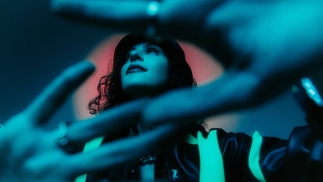LUKE VIBERT: MINING THE ARCHIVES
Leftfield beatsmith on his his funky new library compilation.

You know how it is. That epic, hip-hop crime drama series you’ve been directing is almost finished. But you just can’t find the right track for the final episode’s crucial club scene. You can’t afford to get Snoop in for a session yet, so what do you do? Head straight to a music production library and search the archives until you find 'It': ‘Walk it Like a Dog’, a bolshy rap track bulging with what’s evocatively described as “pure club swagger” and “hot electro flavour” over a “mid-tempo banger” that definitely isn’t a low budget ‘In Da Club’. Nailed it. That’s pure library music right there, as is the wacky cartoon-funk of the ‘Grange Hill’ theme, ‘Countdown’s famous clock-bop and nearly all of the ‘50s, big band instrumentals used in ‘SpongeBob SquarePants’ (don’t pretend you’re too good to watch it). All these TV tracks — and countless others — were taken from music production libraries, vast catalogues of pre-recorded music produced by artists and sold on to the library labels, who then own the copyright and licence out the music, usually to programme makers.
DUSTY DELIGHTS
TV, film and radio have utilised library labels endlessly over the years, as they offer a quick, cheap and efficient way of soundtracking compared to commissioning an original score. And if you’re lucky you might just pick out a gem that sticks in people’s heads and allows your show to live on long after its run finishes — consider the ‘Grange Hill’ theme.
One producer who knows the value of good library music is Luke Vibert, a regular on Warp, Ninja Tune, Planet Mu and other leftfield labels that dig his leanings towards alt. hop, Chicago-leaning house, acid, rave, jungle or whatever else he fancies exploring on any given day.
It’s fair to say that Vibert is something of a library music geek, in the best possible sense. He’s just released ‘Nuggets Vol.3’, the third of his library music compilations that unearth quirky, dusty and frequently funky cuts from the long-forgotten archives of various library labels.
Vibert’s own introduction to library music came via a friend in his local record shop (Falmouth’s now-defunct Records and Tapes), who worked for the Conroy library label.
“I mainly bought them for sampling purposes,” says Vibert. “They were cheap and anonymous and usually very nicely produced.”
Skip forward two decades and little has changed, apart from the price. “They started getting more expensive throughout the '90s, and now some go for hundreds of pounds,” Vibert explains.
The producer’s latest purging is of the Bruton Music Library, an archive he dipped into on previous ‘Nuggets’ compilations, but which is used for the entirety of 'Volume 3'. Bruton was founded in 1977 by Robin Phillips — and purchased by Michael Jackson for a few years in the early '80s — and is now owned at the top end by Universal Music’s production publishing arm, which also holds other well-known library labels such as Atmosphere and Chappell. Before Bruton, Phillips headed another classic library label, KPM (also a Vibert favourite along with De Wolfe: “'60s and '70s KPM in particular sound really lovely... they’re pretty lush right up to the '80s,”), which is now owned by EMI.
Inevitably, pretty much all the popular library labels have been purchased by the big-hitters over the years, but independents still remain. Though it might seem a daunting task searching through Bruton’s hundreds of hours of music to find the nuggets, Vibert simply got stuck in, aided by a ruthless selection policy. “I just checked through every release they had, chronologically... then whittled it down from tons of tracks to the ones released. I’m a pretty fast checker of stuff, so it doesn't take me long to whizz through an album and decide if it’s shit or good.” After some marathon listening sessions, Vibert says he stopped searching when the tunes reached the mid-'80s, “as it was getting too depressingly digital — I prefer the old shit.”
WEIRDER/FUNKIER
So, what kind of oddities made it onto ‘Nuggets Vol. 3’? It’s a 26-track exploration of colourful, cosmic, synth-driven faux-future funk flavours, featuring tracks from some of library’s music’s A-squad, including Francis Monkman, Alan Hawkshaw (composer of what became the ‘Grange Hill’ and ‘Countdown’ themes), and Brian Bennett (‘Prisoner: Cell Block H’ and ‘Birds of a Feather’, for anyone over 30).
There are plenty of zingers on ‘Nuggets Vol.3’, but highlights that really show off the library format include ‘New Technology’ — a bleepy, interstellar disco odyssey — the soaring jazz melodics of ‘Speedbird’, the smiling, funk-rock of ‘Think Big’, and ‘Discovery’, which nails a porn-film-set-in-space vibe like no other. There are also a few straight-up killer grooves that sound less library music and more like they’ve been rescued from some invaluable '70s bargain bin: the spacey, psych-soul of ‘Galaxy (I’m the Ruler’), the Beach Boys-ish vocal unity on ‘In Close Harmony’ and the Mustang swagger-funk in ‘Freshmen’. Beautiful.
Most tracks on Vibert’s latest comp have their own micro-storyline embedded within, often suggested by the track title — a common library music theme. It seems odd — almost too artificial — at first but makes perfect sense when you consider that this is music made in the keen hope of grabbing 30 seconds or so of TV/radio airplay. The artificial nature of the music and shoehorned narrative are, in fact, what make library music beautifully, weirdly unique.
Once you’ve got this idea in your head, it’s impossible not to listen to the latest ‘Nuggets’ and visualise the car chase between the maverick cop and the coke dealer in ‘Fuel Injection’, or the creepy stalker in Brian Bennett’s ultra-sleazy danger-funk cut ‘Prowler’. “A lot [of library music] tends to sound theme tune-ish, as that’s where 90% of all theme tunes came from,” explains Vibert, “so the artists often went for the cheeky, melodic theme vibes, in the hope their tracks would be used for something. There is a slightly cold, detached feeling that a lot of it has, as the musicians are almost too professional to really funk out. Having said that, my faves are usually a different sort, much more experimental — looser, weirder and funkier.”
SAMPLE SOURCE
The idea of writing short pieces of commercially-focused music will no doubt horrify some, but sift through library tracks from decades ago and it’s not difficult to pick up on the roots of various early electronica artists. Plus, there are simply a load of fantastic sounds in there, straddling disco, electro, funk, jazz and other popular genres of the times. As Vibert points out, “It tends to reflect whatever is, or was, happening at the time, so you get such things as punky library LPs, or disco or reggae-ish ones or whatnot.”
One of the many enjoyable eccentricities of library label catalogues is the way in which tracks with similar vibes are grouped together and categorised, often with a snappy description of the mood to let people know what programme or scene the track might be suited to. Looking for some “hot, spicy, rolling beats” to accompany that piece to camera on gourmet Indian food? ‘East Is East’ from the Atmosphere label’s ‘Posh Nosh’ compilation can provide. Searching for something to soundtrack an enigmatic detective uncovering mysterious clues in your low-budget crime drama? Use the swirling, glockenspiel-laden downtempo of ‘Paths to Evidence’ from the ‘Forensic Science & Drama’ album — co-written by wonky techno producer Si Begg.
But library music isn’t just about nostalgia and instruction.
There are plenty of contemporary-focused labels and divisions within labels catering for more modern tastes, offering edgy concoctions such as “bass drivin’ electro stompers” or “full frontal future breakbeats”. A section of the long-standing Chappell label’s catalogue, for example (also named ‘Nuggets’, as it happens), features archive tracks remixed and reworked by the likes of Swayzak, Hot Chip, Murcof, Télépopmusik and The Herbaliser.
But if not for compiling or remixing directly through a label (Vibert was asked by Bruton to dig through the archives for his latest compilation), what can library music offer producers and DJs? Sampling seems the obvious choice, but as the music was never made commercially available to the public (much of it was sent, on vinyl, to the TV/radio station that wanted to use it), it’s difficult to just stumble across that dream vintage sample unless you’re willing to spend a hell of a lot of cash and time on Discogs and eBay. However, tracking it down does have some advantages. “There’s some amazing stuff out there,” says Vibert, “and you’re not as likely to get sued as you are if you sample a ‘released’ album!” But perhaps due to the lack of immediate availability (particularly of the more desirable older material), library music still hasn’t been taken up by as many contemporary artists as might be expected. Asked if he thinks current DJs and producers use or even listen to a lot of library tracks, Vibert’s reply is an interesting one. “I really don’t think so, at least not the awful kind of shite library labels peddle these days. Of course some producers use vintage library samples though. Many European library tracks are sampled by US hip-hop/R&B producers, for example.”
EGOLESS
Like many fans, Vibert’s library fetish is rooted firmly in the genre’s golden years — the '60s, '70s and a slab of '80s. Newer library music, he says, (and newer music generally, in fact) just doesn’t interest him. It’s clear by now that library music represents the height of dedicated electronic music geekery. It’s a solitary and time-consuming process (both for those producing it and those scouring the library archives afterwards) and there’s little money to be made from it unless you’re lucky.
There’s also no real recognition and certainly no glamour, as even when a library tune is pimped out to a hit show, viewers still won’t know who the composer is unless they indulge in some internet research. How many of the elite library musicians mentioned earlier did you recognise?
Then again, the anonymity behind it all is just another intriguing part of the oddball equation for most library music fans. It even offers this most engineered of genres a rare kind of musical purity. “I’m sure that is part of the appeal,” says Vibert, “like when I first heard techno or acid house tracks and didn’t know who they were by or where they came from. It does seem to make it more special when the artist is somewhat hidden, either by choice (dance music) or design (library). Perhaps there’s less ‘ego’ to it, as it’s not about the artist, it’s all about the music.”





